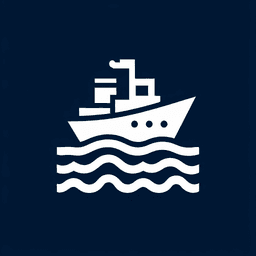
Displacement: Definition, Meaning, and Examples
January 16, 2025
Displacement
In the context of maritime and nautical terminology, displacement refers to the weight of the water that a vessel displaces when it is floating. This is a crucial concept in naval architecture and ship design, as it directly relates to the buoyancy and stability of the vessel.
Displacement is measured in terms of weight, typically in tons, and it is an essential factor in determining a ship's load capacity, speed, and fuel efficiency. The displacement of a ship can be categorized into several types:
- Light Displacement: The weight of the ship without any cargo, fuel, passengers, or crew. It includes the weight of the ship's structure, machinery, and other permanent fixtures.
- Loaded Displacement: The total weight of the ship when it is fully loaded with cargo, fuel, passengers, and crew.
- Standard Displacement: A measure used primarily by naval vessels, which includes the weight of the ship with all its equipment and crew, but without fuel and stores.
Understanding displacement is vital for sailors and maritime professionals as it affects the ship's draft, which is the vertical distance between the waterline and the bottom of the hull. This, in turn, influences the ship's ability to navigate through shallow waters and its overall seaworthiness.
Additionally, displacement is a key factor in calculating a ship's stability and handling characteristics, which are critical for safe and efficient maritime operations.
Understanding Displacement in Maritime Context
What is Displacement in Maritime Terms?
In maritime terms, displacement refers to the weight of water that a ship displaces when it is floating. This is equivalent to the weight of the ship itself, including its contents. Displacement is a crucial concept in naval architecture and is typically used to describe the size and weight of naval vessels rather than commercial ones. It is measured when the ship's fuel tanks are full and all stores are aboard, ensuring an accurate representation of the ship's total weight.
What is Water Displacement in Ships?
Water displacement in ships is defined by Archimedes' principle, which states that the upward buoyant force exerted on a body immersed in a fluid is equal to the weight of the fluid that the body displaces. For ships, this means the displacement is the total weight of the water displaced by the ship's hull when it is afloat. This principle is fundamental in ensuring ship stability and buoyancy.
What is Displacement in Ship Stability?
Displacement plays a vital role in ship stability. It is the total weight of the water displaced by the ship, which according to Archimedes' principle, is equal to the total weight of the ship and everything on board. Understanding displacement is essential for maintaining ship stability, as it affects how a ship sits in the water and its ability to remain upright and balanced during navigation.
What is the Difference Between Tonnage and Displacement?
While both tonnage and displacement relate to the weight of a ship, they refer to different measurements. Displacement is the weight of the water a ship displaces when afloat, which is equal to the ship's weight. Tonnage, on the other hand, often refers to the internal volume of a ship, measured in units of 100 cubic feet. Gross tonnage is a measure of the ship's overall internal volume, while net tonnage is the volume of cargo spaces.
Example of Vessel Displacement
Consider a large transatlantic ocean liner like the Queen Mary 2, which has a displacement of approximately 79,300 tonnes. This means that when fully loaded, the ship displaces 79,300 tonnes of water, illustrating the massive scale of such vessels and the importance of understanding displacement in maritime operations.




